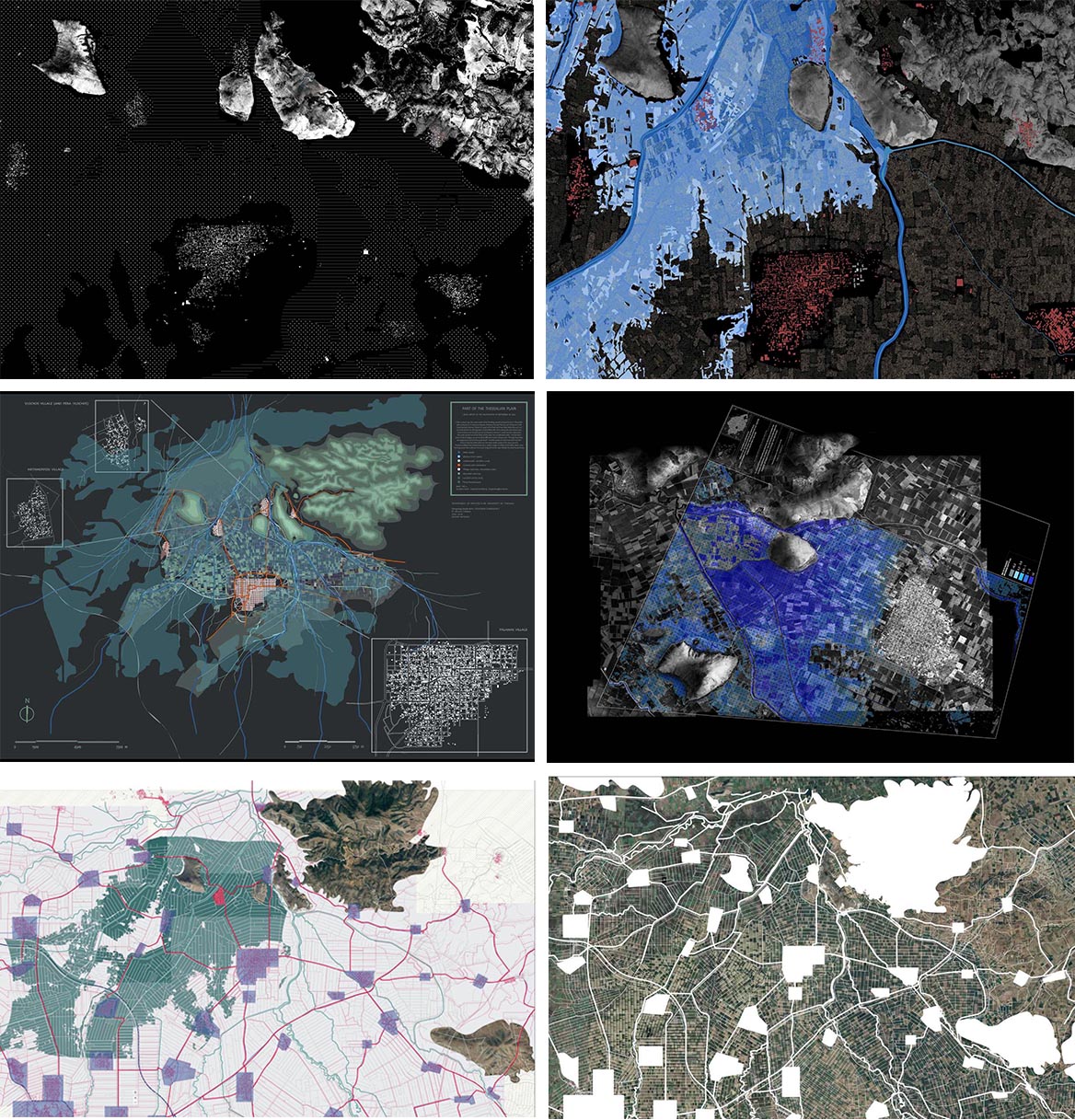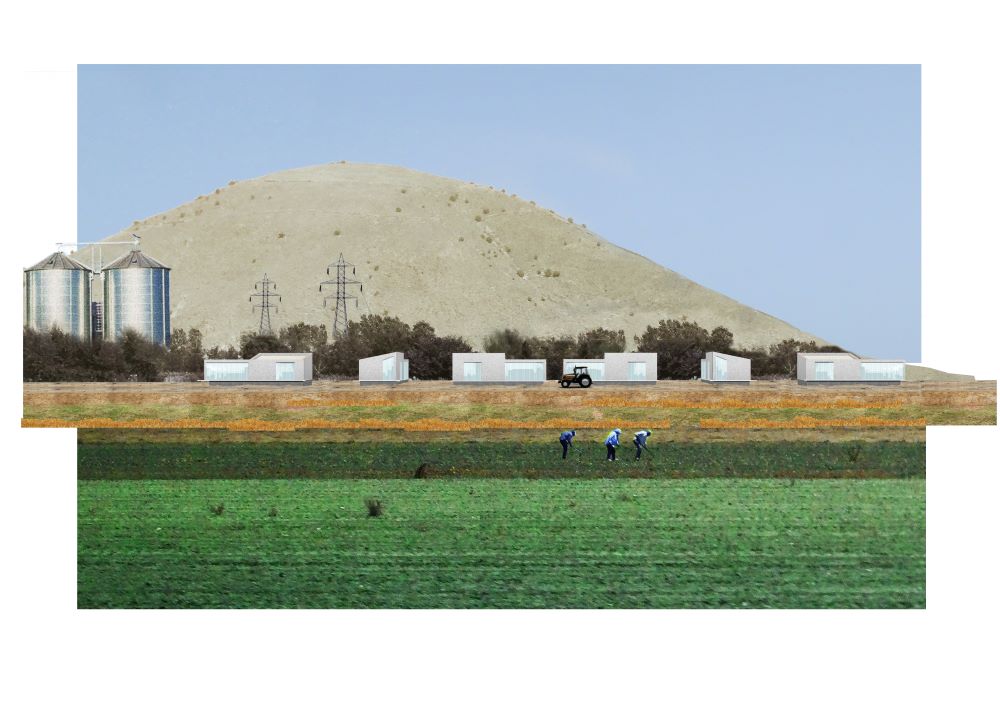Design Studio Required Elective at semester(s) 6, 8, ECTS: 12
Generic Competences: Ability to search for, process and analyse information from a variety of sources using the necessary technologies, Ability to adapt to and act in new situations and cope under pressure, Ability to work autonomously, Ability to work in a team, Ability to work in an international context, Ability to work in an interdisciplinary environment, Commitment to conservation of the environment, Ability to be critical and self-critical , Ability to promote free, creative and inductive thinking.

Spring semester 2024, THE METAMORPHOSIS INTO AN OFF - GRID ISLAND. An amphibious, autonomous settlement, students Thanos Karanikas and Lucia Sofia Paulo Salvador.
Climate change has brought to the fore how the balance between natural and built environment is fragile and constantly under risk. In September 2023, the Thessalian Field saw an unprecedented flooding that has affected production, infrastructure and life of people, creating anxiety for an uncertain future. It is urgent to look for sustainable solutions for the management of future disasters re-negotiating the relationship between people and their environment.
Since the beginning of the 20th century, the Thessalian field has been characterized by a diffuse network of small-size grid villages located in areas with a fragile environmental balance between rivers, mountains and human presence. At the same time, repetitive floodings have questioned the efficiency and security of existing urbanistic models.
This is the occasion to re-think the spatial organization of the human settlements of the region by envisioning new, flexible, scalable, holistic and inclusive strategies to revitalized traumatized communities and create alternative socio-economic models. The course will focus on the design of small communities, focusing on long term post-disaster relocation in safer positions in continuity with the existent.
The studio includes a daily trip to the flooded region of Palamas and Metamorfosi, in the Thessaliko field, close to the city of Karditsa, and meetings with the local community.
.jpg)
Educational trip in Metamorfosi Palamas, Spring Semester 2024.
Knowledge, Comprehension, Application, Analysis, Synthesis, Evaluation
The studio is focused on the entwining relationship between architecture and urban design in the framework of a project that includes the design of public and green spaces and public facilities in an area of the city of Volos. Students will investigate proposals that will challenge a variety of stakeholders and scales. With the conclusion of the course, students will:
know basic techniques of urban analysis thought the use of photography, cartography, diagrams and collage;
- understand the basic urban, planning, historical, environmental conditions that characterize an urban area;
- understand the multifaced problems that affect contemporary cities and the local circumstance and restriction as resources that inform the design;
- learn to analyse, to understand and to use historical and contemporary case-studies;
- know the panorama of urban theories referred to contemporary cities and urban design;
- investigate the role of urban design as a tool to serve collective interests;
- use physical models at the scale of the city and of the building;
- use various methods of representation at the scale of the city (maps, diagrams, images, collage);
- investigate various proposals at the same time; evaluate and judge their work and the work of other students in a sort of horizontal teaching environment.
- evaluate and judge their work and the work of other students in a sort of horizontal teaching environment.

Cartographic analysis, Spring Semester 24.
The course is organized in three phases, and each phase will be completed with a presentation of students’ works, a discussion and an evaluation:
- Urban analysis and Strategic Design: In this phase, students will analyse the geographical scale of the city and the territory, the many questions that urban design should take into consideration and the role of architecture in relation to the city and the environment. Students will work with maps, diagrams and collage though some exercises. This phase will conclude with the definition of a strategic design that will trace the guidelines of the following phases.
- Urban Design: Aim of an urban design project is the transformation of an urban area with a scheme that includes the design of open spaces, new buildings and the creation of a set of actions and activities for the future transformation of the area. Urban design should create a vision for the future of the city΄
- Final Presentation: it refers to the design on buildings and public spaces inside the framework of the masterplan. At the final presentation, students will narrate the scenario that they envisioned for the future of the city.
Each unit of the course will be introduced by a lecture in order to define the framework of the investigation and to understand the objective that students will pursue. Lectures are grounded on the bibliography, case-studies, similar urban strategies, video, interviews. Aims of the lectures are to present the theoretical framework of the subject of the course to open reflection about the condition of contemporary cities with a focus in history, geography, ecology, health and democracy, disaster and reconstruction.

Spring Semester 2024, THE METAMORPHOSIS INTO AN OFF - GRID ISLAND. An amphibious, autonomous settlement, students Thanos Karanikas and Lucia Sofia Paulo Salvador.
Students will work in groups of two. The final grade will be based on exercises, on periodic evaluations and on the final presentation. Attendances in class are required and crucial to take the courses program.
Total assessment 100%:
Urban Analysis 10%
Urban Design 30%
Final Presentation 50%
Participation in class/ initiative/ improvement 10%
(The previous grades are usually considered indicatives to check students' progresses during the course. The final grade may be different from the arithmetic sum of intermediate grades)
Every student must register to the e-class: Εγγραφή στο e-class στον σύνδεσμο: https://eclass.uth.gr/modules/user/index.php?course=ARCH_U_268
Rossi, A. (1991). Η αρχιτεκτονική της πόλης. University Studio Press.
L. Benevolo (2019). Η Πόλη στην Ευρώπη. Πεδίο Εκδοτική
Norberg–Schulz, C. (2009). Genius Loci. Το Πνεύμα Του Τόπου. Εθνικό Μετσόβιο Πολυτεχνείο.
Gehl, J. (2013). Η ζωή ανάμεσα στα κτήρια. Χρησιμοποιώντας το δημόσιο χώρο. Βόλος: Πανεπιστημιακές Εκδόσεις Θεσσαλίας.
– On Architecture and Urban Design
Aureli, P. V. (2013). The Possibility of an Absolute Architecture.MIT press.
Aureli, P. V. (2013). The Possibility of an Absolute Architecture.MIT press.
Bacon E. N. (1969). Design of cities. London: Penguin Books.
Carmona, M. (2010). Public Places, Urban Spaces. The Dimensions of Urban Design. Oxon: Routledge.
Cullen, G. (1961). The Concise Townscape. Oxford: The Architectural Press. [print]
Aureli, P. V., Borra, B., Declerck, J., Tattara, M. & Weiss, T. (2007). Brussels A Manifesto: Towards the Capital of Europe. Rotterdam: NAI Publishing.
Xaveer de Geyter Architects (2002). After sprawl. Brussels: NAI publisher – De Singel.
Ingersoll, R. (2003). Sprawltown. New York: Princeton Architectural Press.
Paola Viganò, P. & Cavalieri, C. (2020). The Horizontal Metropolis. A Radical Project. Park Books.
Gregotti, V. (1953). The Territory of Architecture.
Geddes, P. (1915). Cities in Evolution: an introduction to the town planning movement and to the study of civics. London: Williams.
Lerner, J. (2014). Urban Acupuncture. Washington: Island Press.
Lynch. K. (1984).The Imagine of the City.Cambridge: TheMIT Press. [pdf]
Maki, F. (1964). Investigations in Collective Form. St. Louis: Washington University.
Matvejevic, P. (1999). Mediterranean: A cultural Landscape. Berkeley: University of California Press.
Mc Harg, I. (1967). Design with Nature. New York: America Museum of Natural History.
Mostafavi, Μ., Gareth D. (eds.) (2010). Ecological Urbanism. Baden: Lars Müller Publishers.
Panerai P., Castex J. and Depaule J. (2012). Urban Forms. The Death and Life of Urban Block. Abington: Routledge.
Rossi, A. (1991). Ηαρχιτεκτονικήτηςπόλης. Αθήνα: University Studio Press.
Rowe, C., Koetter, F. (2020). Η πόλη ως κολάζ. Αθήνα: Παπαζήσης.
Tafuri, M. (1976). Architecture and Utopia. Design and Capitalistic Development. Cambridge: The MIT Press.
Smets, M. (2020). Foundations of Urban Design. Barcelona: Actar.
Smithson, A. (1967).Urban Structuring: Studies of Alison & Peter Smithson. London:Studio Vista/ Reinhold.
Shannon, K. & de Meulder, B. (2012). Water Urbanisms. East. Ufo: Explorations Of Urbanism 3. Park Books.
– On Cartography and Representation
Corner, J. and McLean, A. (1996). Taking Measures Across the American Landscape. Yale University Press.
Collective Dragontango (2018). This is Not an Atlas. Verlag. [https://notanatlas.org/book/]
Desmini, J. & Waldheim, C. (2016). Cartographic Grounds. Projecting the Landscape Imaginery. Princeton Architectural Press.
Paez, R. (2019). Operative Mapping. Maps as Design Tools. Barcelona: Actar.
Lorraine, F. (2011). Drawing for Urban Analysis, London, Laurence King, 2011.
Micocci, F. (2021). Athens by Collage. The Representation of the Metropolis between Realism, Intervention and Autonomy. Treviso: Anteferma.
Venturi R., Scott Brown D. & Izenour, S. (1972). Learning From Las Vegas. Cambridge: The MIT Press.
Corner, James. “The Agency of Mapping: Speculation, Critique and Invention.” In Mappings. Edited by Denis E. Cosgrove. Reaktion Books, 1999
Houellebecq, Michel. The Map and the Territory. Knopf, 2012.
– On Post-disaster Urbanism
Didero, M. C. (2012). Toyo Ito: Re-building from disaster. Domus [https://www.domusweb.it/en/interviews/2012/01/26/toyo-ito-re-building-from-disaster.html]
Dimmer, C. (2016). Place-Making Before and After 3.11: The Emergence of Social Design in Post-Disaster, Post-Growth Japan. Review of Japanese Culture and Society, Vol. 28, Design and Society in Modern Japan (2016), pp. 198-226 [https://www.jstor.org/stable/44649896?read-now=1&seq=9#page_scan_tab_contents]
Mihic, T. (2020). Re-imagining Japan after Fukushima. ANU Press. [https://www.jstor.org/stable/j.ctv103xdt4]
Samuels, R. J. (2013). 3.11: Disaster and Change in Japan. Cornell University Press. [https://www.jstor.org/stable/10.7591/j.ctt1xx5k4]
Waldheim, C. (2010). Notes Toward a History of Agrarian Urbanism. Places Journal [https://placesjournal.org/article/history-of-agrarian-urbanism/?cn-reloaded=1]
– On the Thessalian Plain
Rönnlund, R. (2021). The Cities of the Plain. Urbanism in Ancient Western Thessaly. OxbowBooks.
Sivignon, Μ. (1992). Η Θεσσαλίας. Μορφωτικο Ινστιτουτο ΑΤΕ.
Παναγιοωτόπουλος, Δ. Γ. (2022). Οι αγρότες στην ελληνική ιστορία. Αθήνα: Πατάκη.
